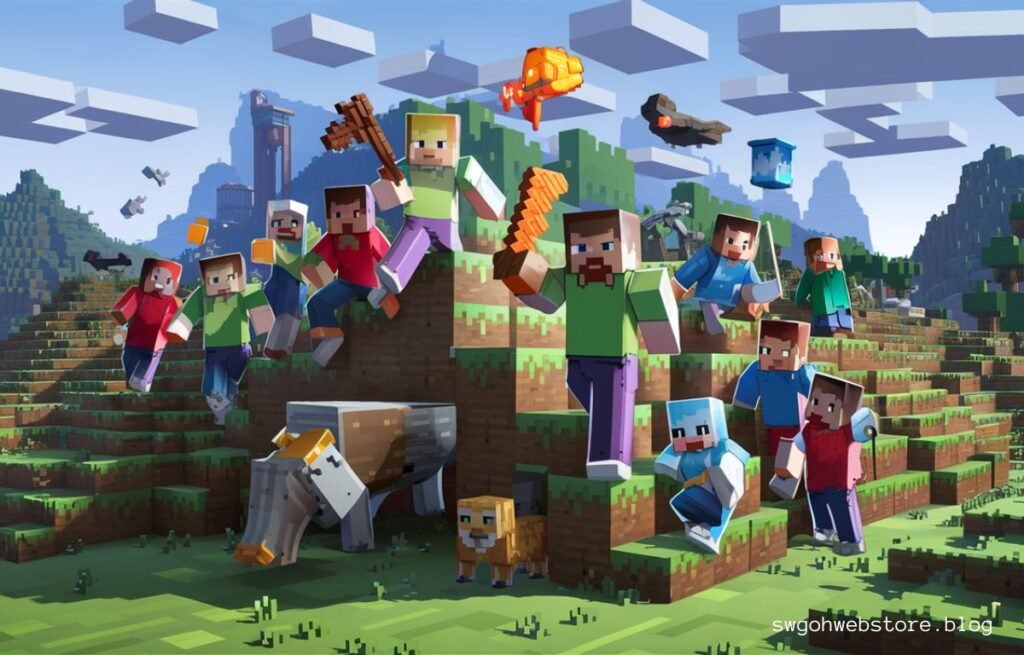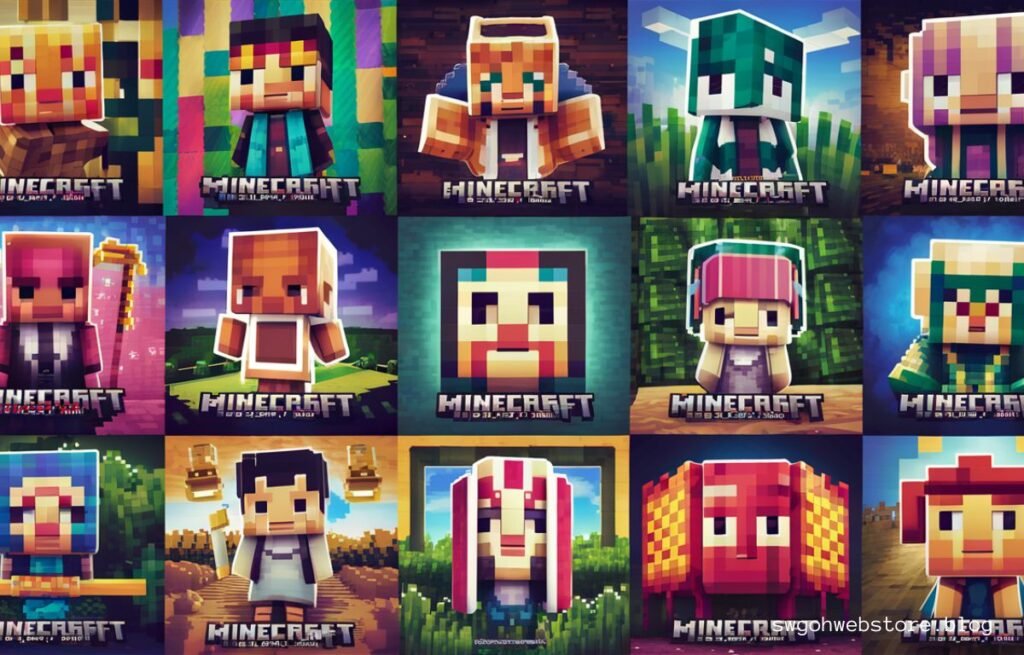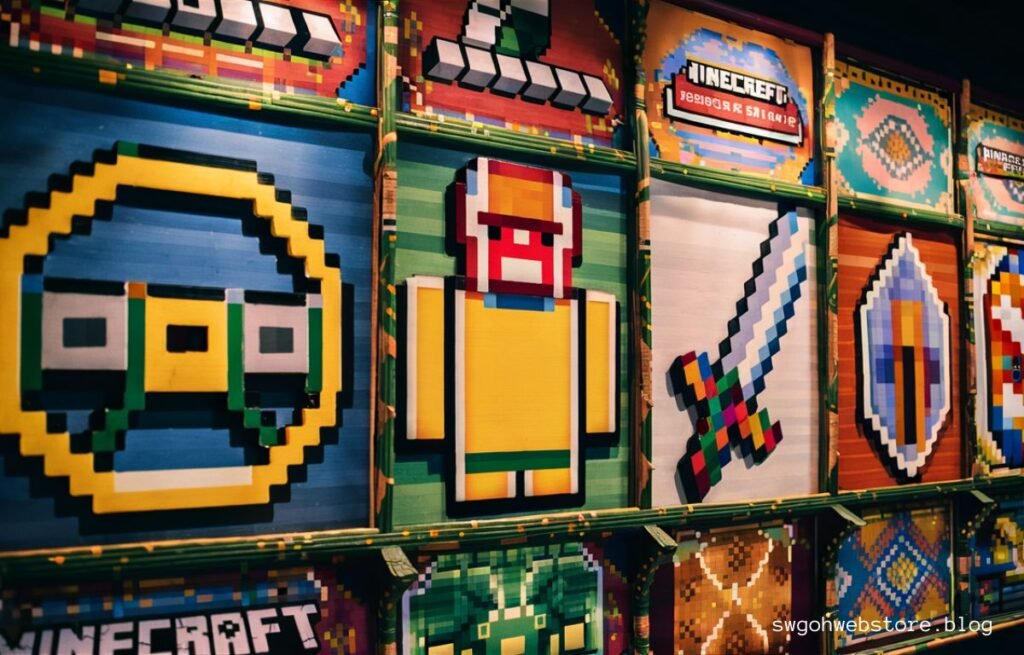Minecraft’s journey from its inception in 2011 to becoming a global gaming phenomenon has been marked not only by its innovative gameplay but also by its evolving visual identity. Among the key visual elements that have captured the essence of Minecraft’s growth are its game icons and banners. These elements not only serve as branding tools but also reflect the game’s development over the years.
Introduction: The Significance of Visual Identity in Gaming
In the realm of gaming, visual identity plays a pivotal role in capturing the attention of players and establishing a memorable brand. For Minecraft’s Bedrock Edition, launched in 2011 as Pocket Edition, the game icons and banners have been integral in communicating its unique pixelated charm and expansive sandbox world.
Early Beginnings: 2011-2015
Minecraft’s initial years saw humble beginnings with simplistic game icons and banners. The icon, featuring the iconic grass block, symbolized the game’s core mechanics of mining and crafting. These early designs were intentionally minimalist, aligning with Minecraft’s indie roots and its distinctive blocky aesthetic that set it apart in the gaming industry.
Establishing a Visual Identity: 2012-2015
As Minecraft’s Bedrock Edition gained popularity on mobile platforms and expanded to consoles, there was a gradual evolution in its visual representation. The game icon underwent refinements, incorporating improved textures and shading to enhance its appeal across different devices. Concurrently, banners began showcasing diverse in-game environments and characters like Steve, highlighting the game’s creative potential and immersive gameplay experiences.
Cross-Platform Expansion and Visual Refinement: 2014-2015
The year 2014 marked a significant milestone with Minecraft’s Bedrock Edition expanding to consoles like Xbox and PlayStation. This expansion necessitated a cohesive visual strategy, leading to further enhancements in both the game icon and banners. The icon evolved to ensure clarity and attractiveness on various screen sizes, while banners became more dynamic, depicting multiplayer interactions and complex in-game builds. These visual updates not only reflected Minecraft’s technological advancements but also its growing community and multiplayer aspects.
Also Read: Unblocked Games Premium: Where Entertainment Knows No Limits
Modernization and Professionalism: 2016-2018

From 2016 onwards, Minecraft embarked on unifying its editions under the Bedrock Engine, aiming for seamless cross-platform gameplay. This period saw a shift towards more detailed and three-dimensional game icons, utilizing advanced textures and lighting effects to enhance visual depth and realism. Correspondingly, banners evolved to highlight the game’s cross-platform capabilities, featuring players from different devices interacting within shared worlds. The visual storytelling became more intricate, emphasizing Minecraft’s collaborative and expansive gameplay experiences.
Current Trends in Minecraft: Bedrock Edition
In recent years, Minecraft’s Bedrock Edition has seen significant updates that have not only enriched gameplay but also revitalized its visual identity through game icons and banners. Let’s delve into the evolution from 2019 to the present, highlighting each major update and its impact on Minecraft’s visual storytelling.
2019: The Village & Pillage Update
The “Village & Pillage” update of 2019 introduced a plethora of new features to Minecraft. It brought new villagers, structures, and the menacing Pillagers into the game’s world. Despite these additions, the game icon maintained its polished and vibrant appearance, ensuring consistency in brand representation while subtly incorporating elements from the update.
Banners accompanying this update vividly depicted scenes of village life amidst the looming Pillager threat. The dynamic art style captured the essence of Minecraft’s interactive environments, showcasing bustling villages and the challenges posed by the newly introduced hostile mobs.
2020: The Nether Update
In 2020, Minecraft underwent a transformative change with the “Nether Update.” This update focused on revamping the Nether dimension, introducing new biomes, mobs like Piglins and Hoglins, and various new blocks. While the game icon remained unchanged in its design, promotional banners took on a darker and more intense theme to reflect the foreboding atmosphere of the Nether.
These banners were rich in detail, featuring the fiery reds of the Crimson Forest and the eerie blues of the Warped Forest. They effectively conveyed the dangerous beauty of the Nether’s revamped landscapes, setting a visually captivating tone. Moreover, 2020 marked the introduction of animated banners, enhancing player engagement through dynamic visual storytelling.
2021: The Caves & Cliffs Update
The “Caves & Cliffs” update of 2021 was highly anticipated and delivered sweeping changes to Minecraft’s underground and mountainous terrain. The game icon subtly adapted to reflect the adventurous spirit of these new landscapes, maintaining its recognizable form while hinting at the exploration opportunities introduced by the update.
Banners for the “Caves & Cliffs” update focused on showcasing the majestic new environments, including towering mountains and intricate cave systems. Players were depicted engaged in activities such as mining copper and interacting with new mobs like the Axolotl and the formidable Warden. The visual style aimed to immerse players in the expansive and adventurous aspects of Minecraft’s updated world.
2022: The Wild Update
In 2022, Minecraft continued to expand its horizons with the “Wild Update,” which enhanced the Overworld with new biomes such as the Deep Dark and the Mangrove Swamp. This update also introduced fresh mobs and blocks, enriching the game’s exploration experience. While the game icon remained consistent with its established brand identity, it incorporated subtle refinements to stay current and appealing.
Banners accompanying the “Wild Update” were vibrant and diverse, illustrating the untamed beauty of the new biomes and their inhabitants. Scenes depicted adventurers navigating through dense mangrove swamps and cautiously exploring the mysterious Deep Dark. These visually captivating banners encouraged players to delve deeper into Minecraft’s evolving landscapes, highlighting expanded exploration opportunities.
2023-2024: Community-Centric Updates and Collaborative Events
From 2023 to the present, Minecraft’s Bedrock Edition has continued to thrive with updates that emphasize community engagement and collaborative creativity. The game icon has remained a symbol of Minecraft’s enduring appeal, while banners have increasingly featured community contributions, player-built structures, and collaborative events.
Recent banners celebrate the creativity and diversity of Minecraft’s global player base, showcasing impressive community builds, community-driven events, and new in-game activities. These banners not only highlight the ongoing evolution of Minecraft but also foster a sense of shared experience and camaraderie among players worldwide.
Visual Storytelling: Capturing Minecraft’s Essence

One of the most compelling aspects of Minecraft’s game icons and banners is their ability to tell visual stories that resonate with players. Each banner serves as a snapshot of a larger narrative, whether it’s exploring underwater biomes in the Aquatic Update or navigating treacherous terrains in the Nether Update. These visuals not only engage players but also serve as effective marketing tools, generating excitement and anticipation for upcoming updates and content.
Behind the Scenes: The Art of Designing Minecraft’s Visual Elements
Designing Minecraft’s game icons and banners is a collaborative effort that involves teams of artists, designers, and developers. From initial concept sketches to 3D modeling and texture painting, meticulous attention is paid to ensuring that each visual element accurately reflects Minecraft’s evolving identity and resonates with its diverse player community. Technical considerations, such as platform compatibility and visual consistency, further enhance the quality and effectiveness of these iconic visuals.
Also Read: Exploring: Wallpaper:hq2hr3icmae= Cats
The Future of Minecraft’s Visual Identity
As Minecraft continues to evolve and innovate, so too will its visual identity. Future advancements in technology, such as virtual reality and augmented reality, present exciting possibilities for enhancing game icons and banners. Imagine interactive banners that allow players to immerse themselves in Minecraft’s world or icons that dynamically change based on in-game events and player interactions. The future holds limitless opportunities to further enrich the visual storytelling and player experience within the Minecraft universe.
In conclusion, the evolution of Minecraft’s Bedrock Edition from 2020 to 2024 has been a testament to its ongoing innovation and commitment to delivering immersive gaming experiences. The period witnessed transformative updates like the Nether Update, Caves & Cliffs Update, and Wild Update, each leaving a distinct mark on the game’s visual identity through game icons and banners.
Throughout these updates, Minecraft has consistently maintained its iconic blocky aesthetic while embracing new visual elements and storytelling techniques. The introduction of animated banners in 2020 added a dynamic dimension to the game’s promotional materials, enhancing player engagement and excitement.
Moreover, the focus on environmental diversity, expanded exploration opportunities, and community-centric updates from 2021 onwards has enriched Minecraft’s world-building capabilities and strengthened its connection with players worldwide. Banners showcasing player creations and collaborative events have fostered a sense of community spirit and shared achievement among the Minecraft community.
Looking forward, Minecraft’s visual identity will continue to evolve alongside its gameplay innovations, ensuring that game icons and banners remain integral in capturing the game’s essence and enticing players to explore its ever-expanding universe. As Minecraft pushes the boundaries of creativity and technological advancement, its visual storytelling through icons and banners will continue to inspire and engage both current players and newcomers alike.

Frequently Asked Questions (FAQs) About Minecraft Bedrock Edition Game Icons and Banners
What are game icons and banners in Minecraft’s Bedrock Edition?
In Minecraft’s Bedrock Edition, game icons refer to the visual representation of the game that appears on devices or platforms where the game is installed. They serve as a recognizable symbol of Minecraft and often reflect the game’s aesthetic or thematic elements. Banners, on the other hand, are promotional images or graphics used to showcase updates, events, or features within the game. They provide players with visual information about new content and gameplay experiences.
How have Minecraft’s game icons evolved over the years?
Since its inception, Minecraft’s game icons have evolved from simple, pixelated representations to more detailed and polished designs. Early icons emphasized the game’s blocky aesthetic, typically featuring elements like grass blocks or characters such as Steve. Over time, as the game expanded across different platforms and received major updates, icons underwent refinements to maintain visual appeal and brand consistency. Modern icons often blend nostalgia with contemporary design elements, appealing to both longtime fans and new players.
What role do banners play in Minecraft’s Bedrock Edition updates?
Banners in Minecraft’s Bedrock Edition serve as visual storytelling tools for updates and events. They are used to announce and promote new features, biomes, mobs, or gameplay mechanics introduced through updates like the Nether Update, Caves & Cliffs Update, and others. Banners showcase key aspects of these updates through vibrant artwork, depicting scenes from within the game to give players a glimpse of what to expect. They help build anticipation and excitement among the Minecraft community while reinforcing the game’s evolving narrative and expansive world.
How do animated banners enhance the Minecraft experience?
Animated banners were introduced to Minecraft’s Bedrock Edition in recent years, enhancing promotional efforts by adding dynamic visual elements. Unlike static banners, animated banners feature moving graphics or sequences that depict in-game activities, environments, or characters. This dynamic storytelling not only captures players’ attention more effectively but also immerses them deeper into Minecraft’s world. Animated banners showcase gameplay dynamics and events more vividly, fostering engagement and interest in new updates and features.
Why are community-centric banners important in Minecraft?
Community-centric banners play a crucial role in highlighting the vibrant and creative community within Minecraft’s player base. These banners often feature player-built structures, community events, or collaborative projects that showcase the diversity of player creativity. By spotlighting community contributions, Minecraft celebrates its players’ achievements and fosters a sense of community spirit. These banners encourage collaboration, inspire creativity, and strengthen the bond among players, making them feel valued and connected to the larger Minecraft community.
How does Minecraft’s visual identity through icons and banners contribute to its overall success?
Minecraft’s visual identity, conveyed through icons and banners, is essential to its success as a globally renowned game. Icons serve as a recognizable symbol that distinguishes Minecraft from other titles, while banners effectively communicate updates and features to the player community. Consistent and appealing visual representation helps maintain brand recognition and loyalty among players. Moreover, icons and banners play a role in attracting new players by showcasing the game’s evolving content and engaging gameplay experiences. As Minecraft continues to evolve, its visual storytelling through icons and banners will remain integral to its ongoing success and growth.
Where can players find the latest information about Minecraft updates and banners?
Players can find the latest information about Minecraft updates and banners on official Minecraft websites, social media channels, and community forums. Mojang Studios, the developer of Minecraft, regularly updates these platforms with announcements, patch notes, and promotional materials featuring new banners. Additionally, Minecraft’s in-game interface may display banners or notifications to inform players about upcoming updates or events. Staying connected through official channels ensures that players are informed about the latest developments and can participate in new content as it becomes available.
Also Read: Film Mijn Reis Custom Video Opnamen Van New York City Vakantie of Huwelijksreis

Emily, an 8-year veteran, blends tech savvy with wanderlust. His fashion-forward perspective and business acumen create captivating content. Explore realms where innovation meets style.